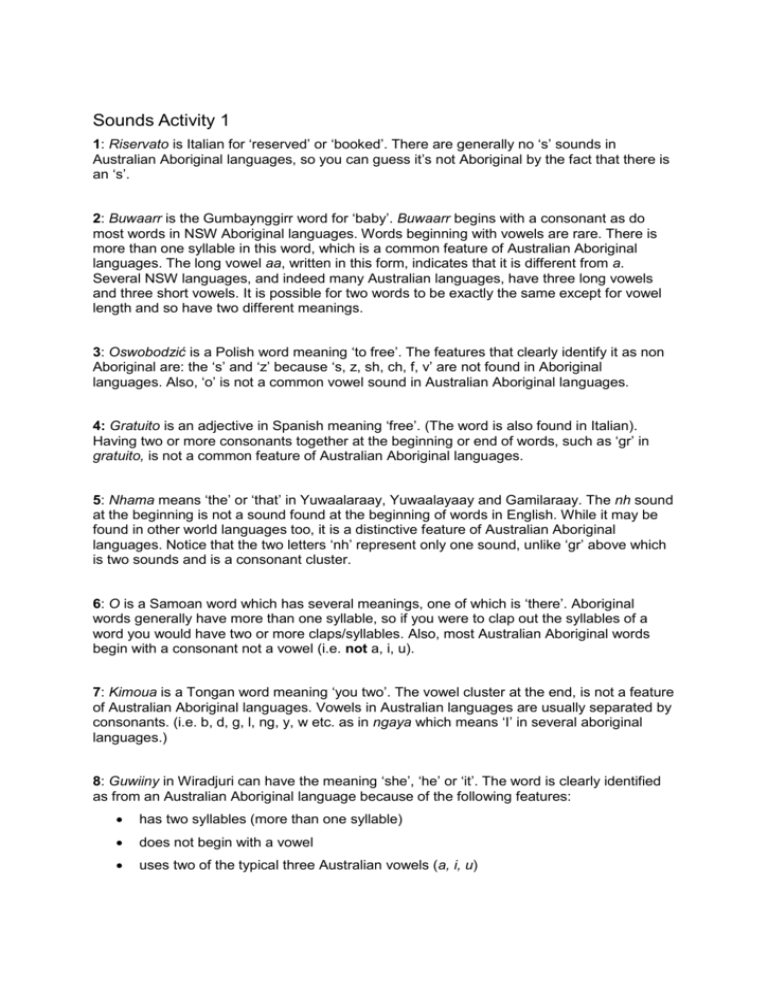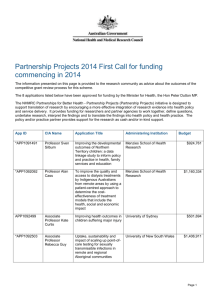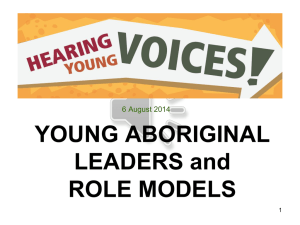Sounds Activity 1.
advertisement

Sounds Activity 1 1: Riservato is Italian for ‘reserved’ or ‘booked’. There are generally no ‘s’ sounds in Australian Aboriginal languages, so you can guess it’s not Aboriginal by the fact that there is an ‘s’. 2: Buwaarr is the Gumbaynggirr word for ‘baby’. Buwaarr begins with a consonant as do most words in NSW Aboriginal languages. Words beginning with vowels are rare. There is more than one syllable in this word, which is a common feature of Australian Aboriginal languages. The long vowel aa, written in this form, indicates that it is different from a. Several NSW languages, and indeed many Australian languages, have three long vowels and three short vowels. It is possible for two words to be exactly the same except for vowel length and so have two different meanings. 3: Oswobodzić is a Polish word meaning ‘to free’. The features that clearly identify it as non Aboriginal are: the ‘s’ and ‘z’ because ‘s, z, sh, ch, f, v’ are not found in Aboriginal languages. Also, ‘o’ is not a common vowel sound in Australian Aboriginal languages. 4: Gratuito is an adjective in Spanish meaning ‘free’. (The word is also found in Italian). Having two or more consonants together at the beginning or end of words, such as ‘gr’ in gratuito, is not a common feature of Australian Aboriginal languages. 5: Nhama means ‘the’ or ‘that’ in Yuwaalaraay, Yuwaalayaay and Gamilaraay. The nh sound at the beginning is not a sound found at the beginning of words in English. While it may be found in other world languages too, it is a distinctive feature of Australian Aboriginal languages. Notice that the two letters ‘nh’ represent only one sound, unlike ‘gr’ above which is two sounds and is a consonant cluster. 6: O is a Samoan word which has several meanings, one of which is ‘there’. Aboriginal words generally have more than one syllable, so if you were to clap out the syllables of a word you would have two or more claps/syllables. Also, most Australian Aboriginal words begin with a consonant not a vowel (i.e. not a, i, u). 7: Kimoua is a Tongan word meaning ‘you two’. The vowel cluster at the end, is not a feature of Australian Aboriginal languages. Vowels in Australian languages are usually separated by consonants. (i.e. b, d, g, l, ng, y, w etc. as in ngaya which means ‘I’ in several aboriginal languages.) 8: Guwiiny in Wiradjuri can have the meaning ‘she’, ‘he’ or ‘it’. The word is clearly identified as from an Australian Aboriginal language because of the following features: has two syllables (more than one syllable) does not begin with a vowel uses two of the typical three Australian vowels (a, i, u) ends with the sound ny, which is a common feature of Australian Aboriginal languages. 9: Nakalaang is a word from Tagalog, from the Philippines , meaning ‘for’ and ‘thing which is being given’. The word could be mistaken for an Australian Aboriginal word, because it: has more than one syllable (four in fact) begins with a consonant uses one of the normal three Australian vowels (a, i, u) appears to have a long vowel. However, the aa in nakalaang is pronounced as two separate ‘a’s which is not the case in Australian languages. (The Australian convention of writing aa, ii, uu is intended to represent long vowels.) 10: Dana is found both in an Australian Aboriginal language (Dharug) where it means ‘foot’ and in Croatian where it means ‘day’. This sort of thing happens from time to time with languages. Sometimes the words may be related, but often, as in this case, it is just coincidence. The fact that dana has more than one syllable; has one of a set of three short vowels (a, i, u), and has no fricatives or sibilants (s, z, sh, ch, f, v) suggests that it could be a word from an Australian Aboriginal language.






